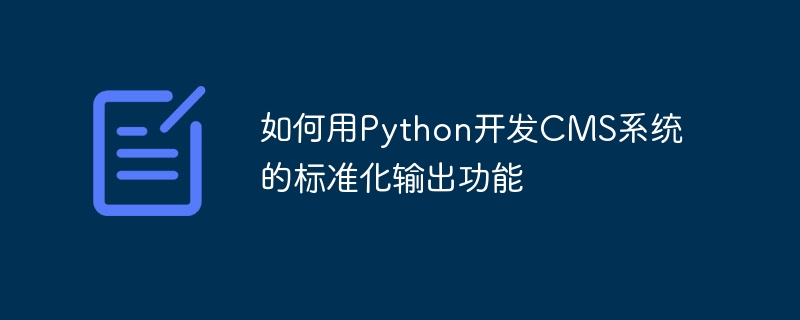

How to use Python to develop the standardized output function of the CMS system
When developing a CMS (content management system) system, an important function is to be able to standardize content format output. This is very important for webmasters and developers as it ensures that all content is presented to users in a consistent manner.
As a popular programming language, Python has powerful text processing and formatting capabilities. In this article, we will introduce how to use Python to develop the standardized output function of the CMS system, and provide code examples to help readers understand.
1. Define the output template
First, we need to define a template for standardized output. This template should contain a variety of text, labels, variables, and loops to generate content as needed.
Sample code:
template = '''
<!DOCTYPE html>
<html>
<head>
<title>{title}</title>
</head>
<body>
<h1>{heading}</h1>
<ul>
{% for item in items %}
<li>{{ item }}</li>
{% endfor %}
</ul>
<p>{content}</p>
<footer>
{footer}
</footer>
</body>
</html>
'''In the above example, the template variable is a string containing HTML tags and variables. It uses Jinja2's template syntax and includes elements such as titles, headings, lists, and footers.
2. Define the data structure
Next, we need to define a data structure to store the content to be output. This data structure can be a dictionary, a list, or an object, depending on actual requirements.
Sample code:
data = {
'title': 'My CMS',
'heading': 'Welcome to My CMS!',
'items': ['Item 1', 'Item 2', 'Item 3'],
'content': 'This is the main content of the page.',
'footer': 'Copyright © 2022 My CMS. All rights reserved.'
}In the above example, the data dictionary contains the values of each element to be output. These values can be modified accordingly according to actual needs.
3. Rendering Output
Now we can use templates and data structures to render output. This can be achieved by using the 'evironment' object of the Jinja2 template engine.
Sample code:
from jinja2 import Environment, BaseLoader
def render_template(template, data):
env = Environment(loader=BaseLoader())
tpl = env.from_string(template)
result = tpl.render(data)
return result
output = render_template(template, data)
print(output)In the above example, the render_template function uses a template and data to generate the output. It first creates an Environment object and loads the template into that object. It then uses the render method to merge the data with the template and generate a string output.
4. Output results
The last step is to save the generated output results to a file or send it to the browser. This can be done by writing the results to a file via the write function, or by sending the results to the client via an HTTP response.
Sample code:
def save_to_file(output, filename):
with open(filename, 'w') as f:
f.write(output)
save_to_file(output, 'output.html')In the above example, the save_to_file function saves the generated output to a file named 'output.html'.
To sum up, this article introduces how to use Python to develop the standardized output function of the CMS system. You can define output templates according to your needs, build data structures, and use the Jinja2 template engine to render the output. Finally, you can save the generated output to a file or send it to the browser. Hope this article helps you!
The above is the detailed content of How to use Python to develop the standardized output function of CMS system. For more information, please follow other related articles on the PHP Chinese website!




